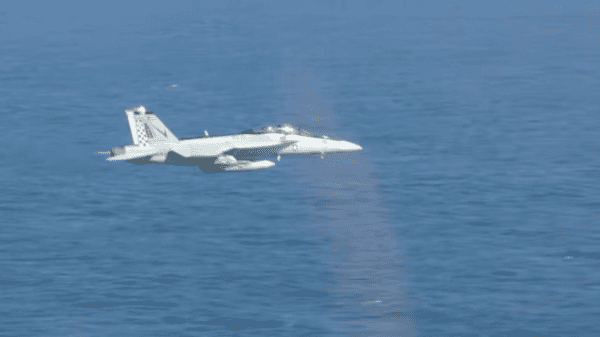Based at Naval Air Station Oceana, the Strike Fighter Squadron 211 (VFA-211), nicknamed the “Fighting Checkmates,” is an aviation unit of the U.S. Navy established in 1945 that is presently equipped with the F/A-18F Super Hornet, itself the premier U.S. Navy fighter and attack jet.
A Strike Fighter Squadron is a unique unit in the U.S. Naval Forces, with the VFA-211 being only the third one to have ever had the designation. According to the Crusader, the first VF-211 was established as VB-74 in 1945, eventually became VFA-211. The second was established in 1948 and disestablished in 1949.

(AiirSource Military/YouTube)
The Checkmates mission is close air support, air interdiction, and aerial reconnaissance, and the unit is currently part of the Carrier Air Wing One aboard USS Enterprise, in the 5th Fleet area of responsibility. This video includes cockpit and pilots’ POV footages of the “Checkmates” of Strike Fighter Squadron (VFA) 211 flying sorties in F-18 Super Hornet jets during USS Enterprise’s 21st deployment.
There is no denying that she is a beauty with quick take-off and landing but when she soars through the sky, she is proud and should be. This U.S. Navy’s front-line carrier-based strike fighter is primarily designed by Northrop Grumman.
The first Hornet model entered service with the Navy in 1983. The design has continued to evolve into the latest iteration, the Super Hornet, which the U.S. Navy started using in 2000. There are two versions of the Super Hornet, the single seat and the two-seater. Both can perform “air superiority, day/night strike with precision-guided weapons, fighter escort, close air support, suppression of enemy air defenses, maritime strike, reconnaissance, forward air control and tanker missions,” according to Northrop Grumman.
The newest upgrades “include an advanced targeting forward looking infrared (ATFLIR), joint-helmet mounted cueing system (JHMCS), multi-functional information distribution system (MIDS), and an advanced aft crew station,” Northrop Grumman added.

(AiirSource Military/YouTube)
The Super Hornet is also equipped to do tactical in-flight refueling to other Super Hornets, making it possible for them to stay in-flight much longer. The aircraft continues to see upgrades to face present-day threats.
The specs on the Super Hornet are nothing shy of impressive. It is “powered by two General Electric F414-GE-400 turbofans. Each F414-GE-400 engines is capable of generating 13,000 pounds of force in dry thrust, 22,000 pounds of force with afterburners,” according to Military Machine.
The Super Hornet is 60.3 feet in length, 16 feet high, and wingspan of 44.9 feet. It can take off with a weight of 66,000 pounds and has an airspeed of Mach 1.8+ and can reach a ceiling of more than 50,000 feet. Each Super Hornet costs $57 million.



